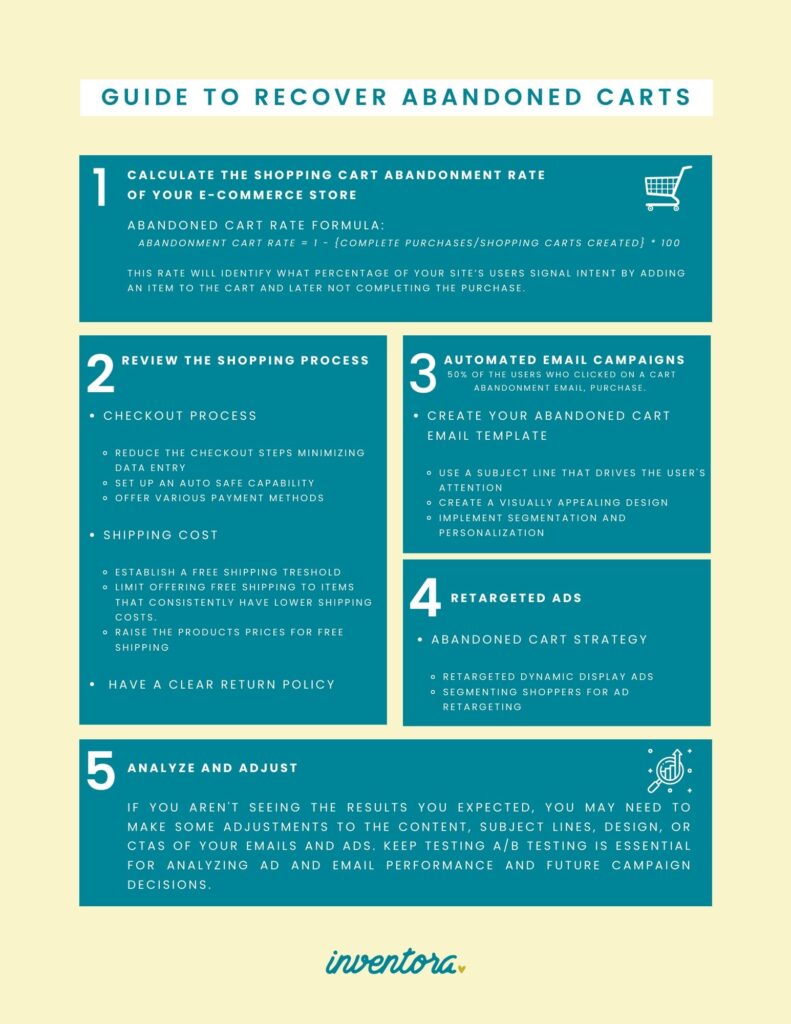
An average of 69.99% of shoppers abandon their carts during online shopping. This happens for various reasons. It is important for eCommerce store owners to understand the significant impact abandoned carts have on their businesses, and how they can avoid this missed financial opportunity. As abandoned carts affect each business nearly 70% of the time shoppers are online, we must take advantage of each opportunity we come across to convert an engaged shopper, to a customer. Inventora’s guide to recovering abandoned carts can help pave the way to profitable wins for your business.
In this article, we will discuss the various reasons for shopping cart abandonment, solutions, and essential considerations while sending out abandoned cart emails. Use this as your guide. With our simple, tactical tools and strategies, you can implemented these actions and improve the cart abandonment rate and revenue recovery for your business.
Abandoned Carts and eCommerce Stores

Shopping cart abandonment is a critical metric for an online storefront process. Shoppers abandon carts when they add items to their cart and leave before completing their purchase. The items that enter the shopping cart but never complete payment are considered to be “abandoned”.
This is major detail that eCommerce stores should pay careful attention to. We must first recognize where to begin in a guide to recovering abandoned carts. You should start by detecting where exactly users are bouncing the website from to clearly understand why shoppers are abandoning the carts. The reasons can include shipping costs, taxes, processing fees, or any other increase in price. The total cost drives more consumers to abandon an online shopping cart than any other detail.
Shopping cart abandonment is an important metric for handmade businesses to detect and correlate conversion rates to revenue. If you have a high cart abandonment rate, it is a strong indicator of friction in the checkout process. The reasonings can also coincide with poor customer experience, or a broken sales funnel. Optimizing your checkout flow must be one of your priorities to avoid hurting your sales and revenue.
How to Calculate a Cart Abandonment Percentage
If you want to have an exact number of cart abandonment in your eCommerce store, the is a way to calculate your shopping cart abandonment rate. Basically, the shopping cart abandonment rate is the total percentage of shoppers who add items to a shopping cart, but abandon it before completing a purchase. This percentage also shows the rate of potential customers who leave without buying anything compared to the total number of shopping carts.
abandonment cart rate = 1 – {complete purchases/shopping carts created} * 100
This rate will identify what percentage of your site’s users signal intent by adding an item to the cart and later not completing the purchase. If you use a simple inventory management software, like Inventora, you will be able to easily gather this data for the cart abandonment reasons behind your store.
Reasons for Abandonment Shopping Carts

Unfortunately, there can be several reasons shopper leave items behind. However, there are four main reasons to consider. Let’s dissect each of those causes and determine a solution for this costly profit loss.
Tedious Checkout Process
A complicated checkout process can create friction and slow down your shoppers. An additional step or form field makes this process more difficult and can also make a potential customer never go back to your site again. Correcting this can be a great cart abandonment solution.
Solutions for tedious checkouts can include…
- Reducing the checkout steps and minimizing the data entry. Optimize the checkout process to make it more streamlined and simple.
- Set up an auto-save capability for users when they abandon their shopping cart.
- Offer various payment methods and multiple checkout options. Consumers love to have different options on the table in order to make their shopping a great experience.
- Send abandoned cart checkout emails. This can work as a reminder and shoppers won’t feel the checkout process as a tedious step.
Cost of Shipping
Currently, 48% of users tend to cancel their order because of the shipping cost or if free shipping isn’t offered. While reading through our guide to recovering abandoned carts, it’s necessary to recognize the powerful importance that free shipping has on e-commerce stores. It can drastically increase conversion rates. These associated costs directly affect net profits. However, there are some ways to maximize your profits with a free shipping offer.
Free Shipping Thresholds: You’ll need to establish an order amount threshold. Meaning customers have to spend a certain dollar amount to qualify for free shipping. Defining that specific amount can be a trial and error process, but look to find the ideal order total for optimal conversions and profit.
Take into consideration these factors: type of industry, cost consistency, or average margin per product. As well as your audience tendencies, how frequently they buy from your store and competition, average order value, and similar behavioral tendencies.
All of these components will take a part in determining the effectiveness of your efforts for minimizing cart abandonment.
Selective Free Shipping: Limit the offer to items that consistently have lower shipping costs. Ideally, this offer includes a more popular selling item with a lower shipping cost. If you’re not sure which of your more popular selling items, Inventora can help you with that data. This simple inventory management software will assist you to choose the correct items for selective free shipping.
Raising Prices For Free Shipping: While raising prices can decrease conversions, it will affect your net profits in a positive way. Increasing prices by 5-10% can often have a positive effect on net margin, even with a slight drop in conversions
Additional Charges
The sudden shock of unexpected costs usually occurs after a shopper has entered their shipping information during the checkout process. This makes the customer rethink their purchase and can be one of many cart abandonment reasons. Some customers even add items to their cart to view the total price. Once they see the additional charges, they feel unsure about proceeding.
The best solution for this is to keep your charges transparent, and provide customers with all charges at the initial stage, including shipping costs, what taxes apply, and additional charges. These charges can be displayed on the product details page. Lastly, you can offer free shipping from time to time. This is a good initiative for reducing cart abandonment, leading to increased sales.
Returns, Payment, and Security Concerns
While shipping fees are significant causes of cart abandonment, 12% is because of the returns policy. Another 18% of users feel insecure about giving their credit card information to the site, and 9% is because of the few payment methods. It’s important to get a full comprehending of this to optimize the potential of Inventora’s guide to recovering abandoned carts.
An unclear return policy will cause customers to leave and find a better return policy elsewhere. Shoppers want to know that if anything goes wrong with the product, they can quickly return it to the retailer and receive a refund.
There are many solutions to these issues. For returns, apps like Returnly or ClickPost Returns Plus make it easier for customers to send back or exchange items after ordering. To gain their trust and have great security and payment options, you can start using standard services like Shopify, Paypal, or Square that can help with both of these issues.
To tidy this up, you can inform customers about the refund and offer a transparent and easily understandable return policy. Offer a simple customer service system to facilitate this. Show your return policy early in the process so that customers are informed prior to and feel comfortable completing the purchase.
How to Recover Abandoned Cart Shoppers

As business owners, we want to recover as many abandoned shopping carts as possible. It’s important to us to do this by increasing revenue in the most efficient way possible. If you search for strategies for this, you’ll find multiple options that you can apply. The most powerful abandoned cart recovery strategy, however, includes retargeted ads and automated email campaigns.
Automated Email Campaigns
Automated email campaigns are the most effective cart abandonment solutions. A high 45% of cart abandonment emails are opened, 21% are clicked on, and 50% of the users who clicked will purchase. Strategically sending messages to shoppers’ inboxes helps convert and recover consumers.
When you create your abandoned cart email template, keep in mind that it needs to be very relevant for the customer. This is a key step in the guide to recovering abandoned carts. Tailor it to their browsing history. This will show the customer that you understand and value their needs and that you’re willing to build a lasting relationship.
Some tips that can help you create your abandoned cart email template are…
Attention Grabbing Subject Line: It all starts with the first thing the shopper sees in their inbox; the subject line. It’s becoming more and more challenging to create unique marketing campaigns.
Your customers are receiving a lot of emails from different brands each day. Some of the unique subject lines use relevant emojis to grab the consumers attention. Many are brands follow the best practice of explicitly mentioning an exclusive offer or referencing what items shoppers abandoned in the cart.
Beyond that, personalizing the email’s subject line to call out the customer’s name can also be effective in increasing engagement and open rates.
Clear Design: Creating visually appealing designs that include images of the product(s) abandoned will help to remind the shopper of what they were interested in buying from an online retailer. Design an email format that fits with your brand voice and marketing messages form this cart abandonment solution.
Most importantly, add clear CTA’s (call-to-action). CTA’s are mainly to grab customer’s attention when opening cart abandonment emails. However, you need a way to direct that attention to where you want it to go. You can do son by including a link that goes directly to the customer’s shopping cart. This is a very crucial step to converting an abandoned cart to a purchased item.
Segmentation and Personalization: Segmented email campaigns have a higher average open rate and more clicks than non-segmented campaigns. This can be the perfect solution for your abandoned cart emails. Segmentation allows you to utilize historical data and spot trends that lead to more sales, more revenue, and overall growth. Knowing what visitors and customers have historically done helps have a clear view on how to satisfy consumers.
Retargeted Ads
Retargeted ads are the standard practice for many marketing strategies. This is because they’ve historically always have worked. In fact, retargeting ads are more likely to be clicked than non-retargeted display ads.
Some retargeted ads that can work as a abandoned cart strategy can include…
Retargeted Dynamic Display Ads: These type of ads let you show previous visitors ads that contain products and services they viewed on your site. These ads make it easier for retailers to create context within retargeted ads by using site data and automated optimization.
Dynamic ads allow retailers to serve the right marketing message on the proper platform. This is based on campaign and are particularly effective when segmenting shoppers. Thus, increasing the ability to target a consumer with a relevant message.
Segmenting Shoppers for Ad Retargeting: Like any other marketing strategy, compiling your own target audience research is key for a successful campaign. In the case of abandoned cart shoppers, you should start by segmenting to the consumers that fail to complete the checkout process.
Wether you choose automated email campaigns or retargeted ads, you need to know the time and frequency. You should do this is in order to recover those abandoned carts. While recovery emails should send within an hour of cart abandonment, retargeting ads can disturb shoppers. This is done when served immediately after cart abandonment.
It’s best to test different timing settings to find the optimal amount of time between cart abandonment and showing an ad. Conducting A/B testing helps optimize creative assets in ads while helping keep ad sets fresh. Therefore, A/B testing is essential for analyzing ad performance and future campaign decisions.
Closing Remarks
In conclusion, we believe you should look at your abandoned cart rate as a potential marketing and growth opportunity. Abandoned cart recovery campaigns are a necessity for any e-commerce store looking to increase sales and grow as a business. Retargeting efforts continue to be a powerful tool for e-commerce, bringing back an average of 26% of users who will complete the checkout process.
Cart abandoners are aware of your brand and products, and they’ve shown interest and intent in purchasing specific items. With the strategies above of retargeting, automation, and segmentation, retailers can recover this previously lost revenue in no time.
Download Inventora’s free guide to recovering abandoned carts below!

In need of a simple inventory management software? Try Inventora for free! Sign up for our hobby plan at no cost, or gain unlimited access to all our features with our affordable business plan. For more business tips like these, join our email list below!


